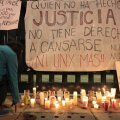David Agren / Fox News Latino / diario19.com

Mass protests in Guerrero have hurt tourism in what was once considered the granddaddy of Mexican destinations.
ACAPULCO, MEXICO
The nightlife pulsed into the wee hours at Baby ‘O, the club famous for attracting the likes of Mexican heartthrob Luis Miguel and even U2’s Bono. Over the recent Revolution Day long weekend, when many were celebrating the start of the Mexican Revolution of 1910, the Acapulco landmark attracted hardly anyone – easily evident by the empty dance floor, idle waiters and absence of a line at the door.
“Everyone cancelled their plans,” quipped one of the doormen, noting that many weekenders from Mexico City were deterred by details of blockades on the highway to what was once considered the granddaddy of Mexican destinations.
Visitors have avoided Acapulco over the past six weeks as protests over the disappearance and possible deaths of 43 teacher trainees has caused chaos on the Mexico City-Acapulco highway and at times the Costera, Acapulco’s main tourist strip. Things worsened for the city last Friday after the U.S. Embassy in Mexico issued a travel warning advising Americans to avoid the Pacific resort city.
The ongoing protests are producing pain for the tourism sector, which generates an estimated 80 percent of all economic activity in Guerrero state – home to both Acapulco and the teacher trainees’ school in Ayotzinapa, which attracts students from some of Mexico’s most marginalized and impoverished municipalities.
Acapulco put Mexico on the global map with a mix of sun, sand and celebrities. It endures as one of the best-known brands in the tourism business – while Guerrero state remained relatively unknown.
Nowadays, “Guerrero is known worldwide,” overshadowing Acapulco for the stories about missing students and mass graves, says Erick de Santiago, president of a private sector initiative known as “Habla Bien de ACA,” or Speak Well of Here. (ACA can mean “here” in Spanish, but is also slang for Acapulco.)
Tourism officials put cancellations at 14,000 since Sept. 26, when the students were allegedly attacked by police officers acting in cahoots with drug cartels, handed over to a criminal gang and, according to the federal attorney general, killed with their bodies burned and their ashes tossed in a river.
Parents and classmates refuse to believe the official version. Protesters in Guerrero have burned government buildings, shut down the airport, looted stores and blocked the Mexico City-Acapulco highway.
“Whenever something happens in Guerrero, there’s this uncertainty for tourists that they’re going find blockades along the highway,” de Santiago says.
A Friday blockade at Tres Marías, a pit stop south of Mexico City in Morelos state, over the kidnapping of a taxi driver lasted 12 hours, causing even more cancellations.
Hotel occupation reached just 50 percent over the long weekend, according to Acapulco mayor Luis Walton – down from 70 percent the previous year. Questions sent to the municipal tourism secretariat went unanswered.
The ongoing protests – with a call for a national strike on Nov. 20, the anniversary of Mexico’s Revolution of 1910 – show no signs of subsiding. Hard hit Acapulco business owners and employees are calling for calm, but some express sympathy for the students and their families.
“It’s important that they fix this problem with the families,” says Urbano Flores, who hawks banana boat rides and rents umbrellas and beach chairs.
The scandalous stories generated in Guerrero are but the latest hard luck for Acapulco, which has slid in stature over the past 25 years – going from jet-setter playground to a city associated with crime and calamities.
Acapulco’s fortunes started fading in the 1990s as the Mexican government bet big on beach resorts like Cancún, Los Cabos and Ixtapa – at the expense of Acapulco, which has been poorly promoted abroad and now principally pulls in people from Mexico City, five hours up the highway.
The 2009 H1N1 viral outbreak made matters worse by scaring tourists away from Mexico. A spate of organized crime killings have compounded the problems, especially the 2010 abduction and murder of 20 men from Michoacán state, who were misidentified by their killers as cartel rivals.
Tourism started bouncing back, though, as Mexico City residents returned to Acapulco because of stepped up security and an ongoing nostalgia for a place many Mexican profess to have a soft spot for.
“It’s tradition for many people,” says Lucia Cárdenas, a supervisor at the Banyan Tree resort – where some guests avoided the blockades by taking commercial flights to Acapulco.
“It’s sentimental, too. People have had a lot of first experiences in Acapulco: first nightclub, first beach, first weekend away,” she says.
Twin storms that battered both of Mexico’s costs in September 2013 undid some of the success as floods submerged parts of the city and left tourists stranded during a long weekend.
Catholic priest Father Jesús Mendoza says officials’ attention has always tended to toward tourism, while ramshackle barrios in the hills high above Acapulco Bay suffer from crime, water woes and substandard public services.
“There’s been enormous neglect,” says Father Mendoza, director of a ministry providing attention to victims of violence. “They have had some programs, which are little more than makeup and have the purpose of improving the image of the city, even while the reality is very difficult.”
“They haven’t had the outrage necessary to recognize the depth of the problems,” he adds.
De Santiago says tourism operators in Acapulco recognize the status quo cannot continue.
“Acapulco doesn’t need promotion,” he says. “What Acapulco, Guerrero and many other states require is that there’s justice and security.”
David Agren is a freelance reporter living in Mexico City.








